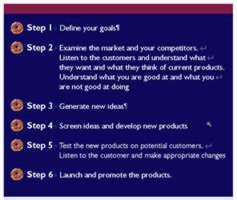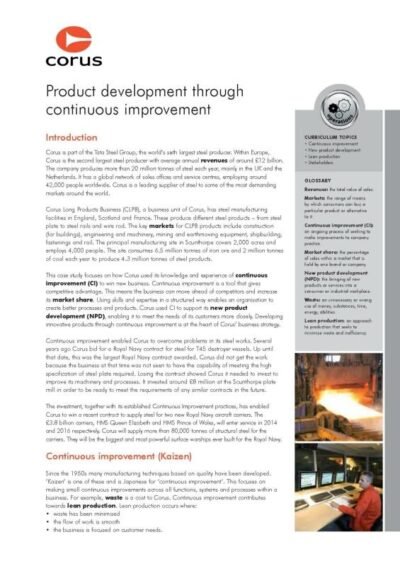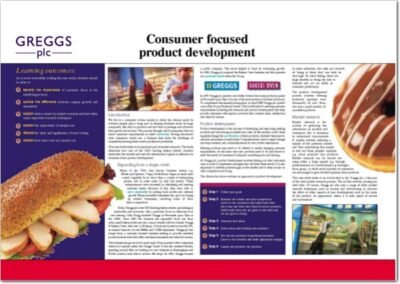
We live in a consumer driven society in which the choices made by ordinary people play a large part in shaping decisions made by large companies, like what to produce and how best to package and advertise their goods and services. The process through which companies find out about consumer requirements is called marketing. Having discovered what customers’ needs are, a business then faces the challenge of completely meeting those needs quickly and profitably.
This case study looks at an important part of market research. The study illustrates how one of the UK’s leading bakery related retailers researches the market and uses the information it gains to influence its decisions about product development.
Expanding from a single outlet
Many of the UK’s best known business names e.g. Marks and Spencer, Virgin, Rolls-Royce began as small units owned originally by no more than a couple of enterprising people, and in some cases by only one person. These entrepreneurs were successful in identifying and meeting customer needs. Because of this, they were able to grow organically by putting back profits into internal growth. Many successful businesses also grow by buying up related businesses, including some of their direct competitors.
Today, Greggs plc is the UK’s leading bakery retailer, specialising in sandwiches and savouries, with a particular focus on takeaway food and catering. John Gregg founded Greggs in Newcastle upon Tyne in the 1930s. Since 1964 the business has expanded from one shop with a small bakery at the rear into a major retailer with two brands; Greggs & Bakers Oven, with over 1,150 shops, 13 factories located across the UK, an annual turnover of over £400m and 17,000 employees. Greggs plc has always been a customer focused business seeking to provide excellent products and services that offer customers enjoyment and value for money.
The business has grown in two main ways. It has acquired other companies which now operate under the Greggs’ brand. It has also invested heavily, spending around £8m on building two new bakeries in Birmingham and North London, each able to service 100 shops. In 1984, Greggs became a public company. This move helped to fund its continuing growth. In 1994, Greggs plc acquired the Bakers Oven business, and this operates as a premium brand within the Group.
In 1997 Greggs plc opened a new £10m Central Savouries production plant in Newcastle upon Tyne. It is one of the most modern of its kind in Europe. To complement this manufacturing plant, in April 2000 Greggs plc opened a new £2m Group Technical Centre. This is dedicated to meeting customer requirements by leading the research and product development that help provide customers with superior products that combine taste, satisfaction and value for money.
Product development
Product development is the process of developing and improving existing products and introducing successful new ones. In the modern world, firms regularly change the specifications of their products, whatever they may be, aerosols, aeroplanes or sandwiches. Consumers have come to expect change and improvement, and continually search for new, better experiences.
Existing products may need to be altered to satisfy changing customer requirements. At the same time new products need to be introduced to meet the needs of consumers looking for something new and exciting.
At Greggs plc, product development involves finding out what customers want in order to implement strategies that will meet these needs. It is also important to identify potential gaps in the market and to keep an eye on what competitors are doing.
The illustration below outlines an approach to product development.

In some industries, the risks and rewards of ‘being in there first’ can both be
very high. In retail baking, there are large benefits in being the first to identify and act on shifts in consumer preferences.
The product development process involves filtering hundreds (perhaps even thousands) of new ideas into just a small number of successful products.
Market research
Market research is the activity of gathering the information on markets and consumers that is necessary to understand requirements. It usually involves selecting a sample of the potential market and then questioning this sample to find out these peoples’ opinions e.g. about potential new products. Market research can be carried out using either a large sample e.g. through questionnaires, or a small sample e.g. through a focus group, in which small numbers of consumers are encouraged to give detailed opinions about products.

This case study looks at an activity that is, for Greggs plc, a key part of the total market research process. The activity involves carrying out taste tests. Of course, Greggs plc also uses a range of other market research techniques, such as surveys and interviewing, to discover the effect of other aspects of new developments such as the name of the product, its appearance, where it is sold, speed of service and convenience.
Carrying out taste tests
Taste tests are ideal for goods such as food that are consumed directly. Researchers working for Greggs plc use taste tests to obtain detailed information about customer perceptions. The particular method used is called a Hall Test. This is a popular quantitative market research technique in which interviewers recruit random respondents on the street and invite them to take part in the research.

With taste tests, respondents eat products within a controlled setting and then give their opinion on them. These tests can be used to:
- track views on a product over time
- assess changes or improvements made to a product
- gauge reactions to a new product.
Taste tests require ‘blind testing’ i.e. – respondents are unaware of the identity of the brand being tested. This eliminates any bias that might otherwise occur in the results due to respondents’ pre-conceived ideas about a particular brand or food retail outlet. Respondents are also kept unaware of any changes that may have been made to a product e.g. a different dressing in a sandwich. This ensures that their comments are not influenced by any prior knowledge.
With a taste test, it is good practice to test no more than three products in a session. This should ensure that respondents’ taste buds are not overloaded.
Greggs plc carry out two main types of taste test:
- Single Product Test
This involves respondents testing one product only and then giving their views on that product. This can be repeated over time. In this way, the business becomes aware of any changes in consumers’ tastes or perceptions.
- Comparison Test
This involves respondents trying more than one variant of the same product e.g. the same filling in different types of bread and then being asked to state their preference. This approach is good for making comparisons but it does not produce enough data about the qualities of a single product and leaves important gaps in information. For example, a respondent could state that they preferred product B to product A without being required to reveal that they did not like, and would not buy, either of them!
Advantages of taste test methodology

The same taste test can be carried out many times in a standard way, under rules set in advance. In this way, a business can collect valuable, valid data that allows useful, reliable comparisons to be made. For any business, the most relevant views come from those people who are most likely to buy and use the product. Having identified that group, an appropriate sample can be selected for testing using a screening questionnaire that provides the right balance of age, gender and frequency of purchase.
Small-scale v large-scale tests

Testing is an expensive exercise. Although it is helpful to carry out tests on as large a sample as possible, it makes good economic sense first, to conduct a sample test using perhaps 30 people to obtain an initial reaction to a product. If it proves to be well received then large-scale tests can be carried out on samples of not less than 100 people.
Rules for accurate taste testing
Some important basic rules in carrying out an accurate taste test are:
- Location
Provide a facility in which respondents are given individual privacy. In that way, they are not in a position to influence each other.
- Equipment
Provide a table and chair for both the respondent and the administrator. Display the products on a plate. Provide each respondent with a glass of water with which to cleanse their palate after each testing. Provide a questionnaire. Examples of questionnaires are provided on the website at www.greggs.co.uk.
- Respondents
Choose interviewers and respondents who are not linked in any way to the product and so have no great wish or need to see a particular outcome to the test.
- Sample size
Consider running an initial test with just 30 respondents as the sample. If it proves successful, then carry out further tests using a much larger group.
- Product preparation
Present the product in an appropriate way that is as close as possible to how the final product would reach a consumer if production went ahead. This may involve making sure that for every respondent the product is at the right temperature, cut to the desired size and properly prepared e.g. buttered and also to ensure each product can be identified by giving it a 3 digit code e.g. 007.
- Questionnaire
Make sure the questions are unambiguous and likely to produce clear answers by covering the aspects that you most want and need to know about.
- Carrying out the test
Invite respondents to take a drink of water before tasting any product. Ask questions only after a product has been tasted. When comparisons are being made between products, ask questions only after all the products have been tasted.
- Rotation of order
In comparison tests, ensure that different respondents taste the products in a rotating order e.g. invite the first respondent to try 007 before 008, and the next to try 008 before 007.
- Results
Set out the results as percentages and show clearly the number of respondents involved (the sample size). For small samples, results can be calculated ‘by hand’. Larger samples require a data processing package like Excel.
Large-scale tests

New product development should be consumer-led. Once a small-scale test provides positive results then product testing needs to be carried out on larger representative samples of real consumers. A market research agency will carry out the detailed survey for the company. The larger the sample of respondents who test a product, the more reliable and representative of the population as a whole the results will be.
It is vital to test a product amongst as large a sample of the target market as possible whilst remaining within the financial and time constraints of the project. Conducting 100 interviews in a day is regarded as a reliable sample size for a product taste test.
Conclusion

Consumer driven companies use market research to find out about the needs and requirements of their customers. For producers of foods, properly conducted taste tests are an excellent way of gauging consumers’ views in order to inform ongoing product development. Greggs plc is heavily committed to providing good value, high quality products to its customers. In order to do this, Greggs plc place great faith in this type of research, and the firm’s growth is testimony to the success of its approach.
 Product development through continuous improvement (PDF)
Product development through continuous improvement (PDF)  Consumer focused product development (PDF)
Consumer focused product development (PDF) 